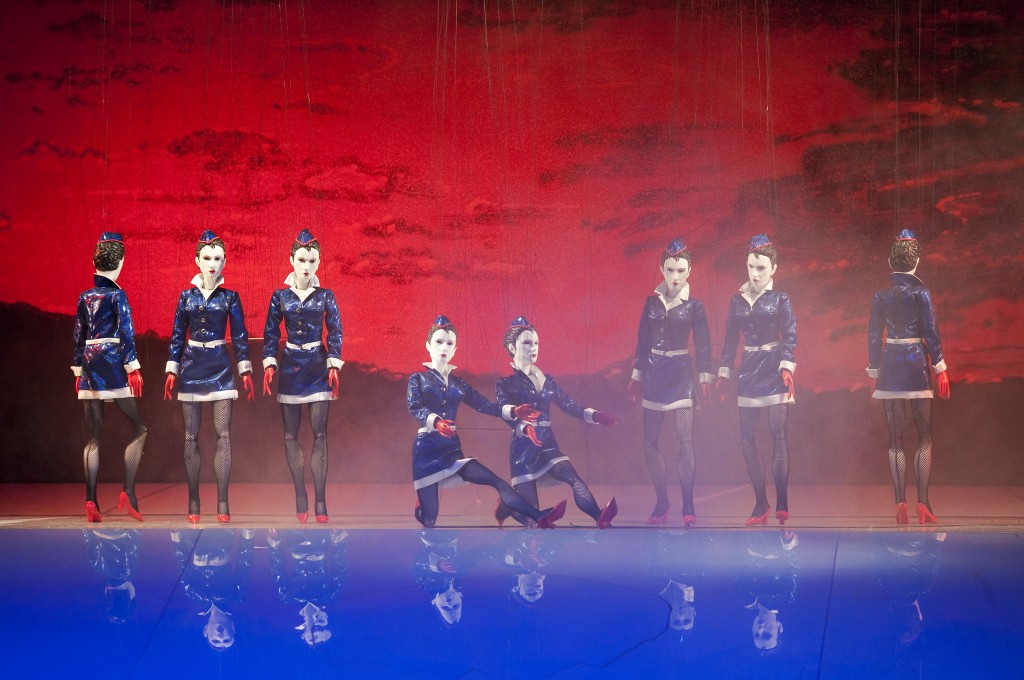They must be puppets: Magical Salzburg Marionette Theatre runs Rings around Wagner

The Valkyries assemble in the Salzburg Marrionette Theatre’s take on Wagner’s “RIng” at the Met Museum.
Four days, sixteen hours; that’s the length of Wagner’s Der Ring des Nibelungen. Those numbers are repeated several times during the neat two hours of the Salzburg Marionette Theatre’s ingenious, greatly condensed Ring, presented Friday night at the Metropolitan Museum of Art. Their Ring is vividly entertaining and profoundly serious.
Two hours is even more compact than the tightest and best of the original operas, Das Rheingold, and there was no skimping the drama, essential plot and most powerful musical moments. The cuts work via two charismatic narrating actors, He and She, who condense scenes, describe actions not shown on stage, comment on the events, voice some of the puppets and appear as some of the characters in the staging. All the major characters are represented by marionettes, who pantomime singing to excerpts from the classic Georg Solti Ring cycle on Decca.”
The narration is, blessedly, highly irreverent. The Ring is packed with extraordinary music and drama, but the three main operas – Die Walküre, Siegfried and Götterdämerung – have librettos that grow increasingly bloated. This adaptation finds the key moments that distill Wagner’s meaning and set his superfluous grandiosity in relief.
An example that incises the brilliance of the Theatre’s reading is when He (played by Yoann Moess) speaks for Siegmund; instead of the lengthy duet between that character and Sieglinde in Die Walküre, he cries out “I laugh out loud in sacred passion!” The simultaneous seriousness and ridiculousness encapsulates the bizarre fever of the drama and the key mechanism in the plot.
Yes, bizarre. Wagner wanted his gods to be men, and vice versa, and ended up with characters who are erratic, inconsistent, immature and often dull. Their fervid needs and base intrigues are impressive for their exaggerated quality, but they are far distant from common human experience and connect only with the fantastic imagination.
Cutting down the story of the Ring – how the ring itself came to be, who burns for it and whom it destroys – restores the essence of the myth, and pushes the drama past Wagner’s weak and weird plotting. Siegfried does away with the dragon Fafner, here a blow-up puppet that’s a cross between Jabba the Hut and The Buddha, and, in He’s words, “accidentally kills Mime.” That ties up a loose plot thread tighter then the most ruthless Hollywood producer could.
As for weird, the narration consistently and unabashedly points out that Siegfried is the product of incest, and that his relationship with Brünnhilde is a passionate love affair between aunt and nephew. Yes, there are copulating puppets.
She (Christiani Wetter) also argues against the clichéd sexism in the plot, as in Freia’s worth being measured in the stacked Rhinegold used to pay off Fafner and Fasolt, “two master builders from Eastern Europe,” who put up the luxury estate of Valhalla for Wotan. The King of the Gods wears a tuxedo and drives a classic Thunderbird convertible, he’s joined in modern dress by Loge (voiced by Steven Sayer, who later doubles as Hagen) in a red sequined dinner jacket, Freia in a low cut minidress and Siegfried in a track suit. Brünnhilde wears an elegant gown, and her sister Walküren, kicking like the Rockettes, are decked out in leather jackets and miniskirts, like a motorcycle gang of flight attendants.
And there is indeed a motorcycle. Siegmund rides in on his chopper like Dennis Hopper from Easy Rider. The contemporary viewpoint powers the irreverence towards Wagner. But using puppets creates a staging that is truer to the composer’s ideas than any traditional one could hope to achieve. Humans can’t sing while swimming underwater, but puppets can and it is shockingly beautifully to see the Rhine maidens float through the air during their song.
The interaction between He and She and the puppets re-contextualizes the story into firmer reality but also deeper myth. When they join the action on the miniature stage as Fafner and Fasolt, when He becomes Hunding and, in the last act, when the actors don letterman sweater and flouncy skirt as Gunther and Gutrune, the differences in physical scale are important and astonishingly effective. They might be giants? They are giants!
This staging is monumental and real in ways that no monstrous machine can duplicate. After puppet Hagen spears puppet Siegfried in the back, Gutrune gathers up the figure, limbs dangling loosely, wraps him in his marionette rigging and gently lays him on the funeral pyre. The image is amazingly powerful, an immediate, physical realization of the essence of the story: the incontestable power of fate.
From the beginning, the gold will be returned to the Rhine maidens, and the process will destroy humans and gods alike. The characters are puppets of Wagner’s imagination, the marionettes on stage the appendages of human actors and puppeteers. Despite the cult that endures around him, Wagner was nothing more than a man, a flawed genius. This production is true to him and the weakness and strengths of the Ring, and should be seen by anyone who loves Wagner, and anyone who loathes him.
The Salzburg Marionette Theatre’s Der Ring des Nibelungen will be repeated 6:30 p.m., Saturday at the Metropolitan Museum of Art. metmuseum.org